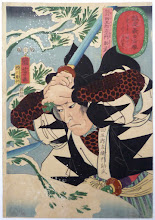This morning I took part in a bit of discussion on how to best organize an "oriental adventures" style supplement over at Joseph Bloch's Greyhawk Grognard blog.
That discussion caused me to give thought all day to just what, exactly, represent core hero archetypes or tropes in Asian myth, legend, literature, comics, and modern period cinema (Wuxia, Chanbara, etc.).
Now, I know the CHCs (Confucian Heritage Cultures, China, Korea and Japan) best, so these ideas are more for general East Asia, not so much for Central, South or Southeast Asia, although they may apply there as well.
This is also more of a first draft thought experiment, so feel free to chime in with thoughts for revisions or improvements, especially any archetypes you think I've missed. I've only been considering this since this morning, yet it's something that's been rolling around in my head for years in a way.
Hero Archetypes for Asian-Inspired Gaming
Stalwart Warrior - This is the hero who serves some greater power, such as the stereotypical Japanese samurai or Korean hwarang, or many of the heroes of the Chinese Three Kingdoms like Guan Yu and Cao Cao. Much martial ability, along with a code of conduct and a desire to support the social power structure and advance within it.
Righteous Vagabond - This is the hero who wanders the land, serves no one yet still lives by a strong moral code. Think Cain from Kung Fu, wandering ronin like Sanjuro (Toshiro Mifune's character in Yojimbo and Tsubaki Sanjuro), and most xia in Wuxia movies like Li Mu Bai in Crouching Tiger Hidden Dragon.
Driven Martial Artist - This is the hero who dedicates their life to mastering their martial art. They could be unarmed fighters like most Bruce Lee characters, sword-masters like Musashi Miyamoto (the historical one or the fictionalized one), peerless archers, etc.
Benevolent Mendicant - This is the hero who wanders the land seeking to help all those in need, and need not be a religious figure, although many are. They may have some martial prowess, but their primary aptitude is empathy and an ability to bring people together. Song Jiang, the main leader of the bandits in Outlaws of the Marsh fits this type, as do many wandering Buddhist priests or monks in Japanese fiction.
Wily Strategist - This is the hero who always has a plan to defeat any problems that beset them. Master tacticians like Zhuge "Kongming" Liang and Shima Yi in Three Kingdoms fit this mold, but many ninja heroes such as the historical Hattori Hanzo or Rikimaru and Ayame from the Tenchu video games could also be considered as well.
Mystical Trickster - This is the hero who uses magical powers to overcome challenges, often in creative ways. Monkey/Sun Wukong in Journey to the West is the prototype of the archetype, but magical powered ninja like the Eight Demons of Kimon in Ninja Scroll or Ryu Hayabusa of the video game Ninja Gaiden also fit.
Learned Sorcerer - This is the hero who has a studied esoteric texts, able to manipulate magic, or spirit companions, to overcome problems. They may have studied rigorously to gain their powers, such as the One-Eyebrow Priest of the Mr. Vampire movie series, or the Korean Jeon Woochi, the Taoist Magician from the film of the same name are examples.
Orphaned Changeling - This is the hero who was born with innate magical powers, or discovered and raised by humans as one of them, when in actuality the hero is from the Spirit World. Japanese fairy tale heroes like Momotaro, Kaguya-hime, and Kintaro are examples of this type, as is the legendary founder of Korea, Dangun.
Cover Design
53 minutes ago






Looks good to me!
ReplyDeletenice breakdown of the archetypes!
ReplyDeleteCallous Avenger - often has a change of heart to become truly heroic, or sinks into hatred that can only end on the battlefield. Inspired by most of Brigitte Lin Ching Hsia movie roles...
ReplyDeleteGood one, Lee. The main character, a slave who is a former warrior, in the Korean movie Musa also fits that mold.
Delete